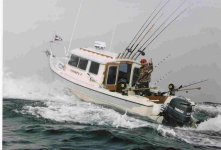Dusty-
Another refinement on the wave business for our fellow voyagers: Besides the period (spacing), one other factor that could stand some more elaboration is the current movement.
When sailing 14 foot dinghy sailboats in an Francisco Bay, it made a HUGE difference which way the current was going in the wind chop. With the current laying the waves down, wind waves were a piece of cake compared to the opposite effect when the opposite current movement stood them up into steep walls of sometimes nearly vertical water.
When the wind waves and current move in the same direction, the parallel motion of the water lays the tops and faces of the waves down to leeward, making smooth rolling waves.
If, on the other hand, the current runs opposite the direction of the waves, the tops and faces of the waves are stood up and are slowed down, if not stopped, by the current's motion of the water moving in the opposite direction. These wave fronts are steep and make for a difficult ride from any angle, but particularly going upwind into them. Ride 'em cowboy!
By comparison, we used to race the 14 footers and even 8 foot El Toros in the ocean down in Monterey, Ca. The ocean currents were much less than in S. F. Bay, and we'd sometimes experience ocean swells that would make the 14 foot masts of other El Toros disappear. But it was all great fun, as the swells were so gentle and far apart as to like having a giant blue golf course pass under you as you sailed along over the gently rolling hills!
Lastly, another factor: depth of the water. Not really a factor most of the time, but don't ask the folks going out over the bar, any bar, except the Honky Tonk Type. Shallow water stands up the waves until they break, making for the most extreme case of wave hazards commonly experienced. No wonder the Coast Guard trains the Surf Boat Coxwains on the Columbia Bar. When the water depth equals 1 1/2* the wave height, the waves break just as they do in the coastal surf, and as you guessed it, the outgoing current and incoming waves stand each other up into breaking conditions and that can equal much more breaking than just waves.
Sorry to drag this out, I know you, Dusty, understand all this, it's just fun to
muse along, help some others better understand some of the things we deal with in boats, and practice my old trade a bit.
* as I remember the number. For a real detailed discussion of this, study the circular particle motion in waves and you'll easily see why these phenomena occur.
Enjoy your shrimp, Duster!!!

